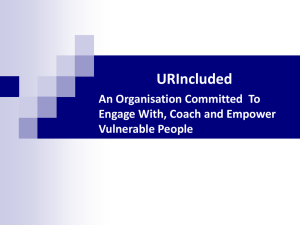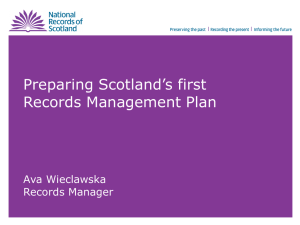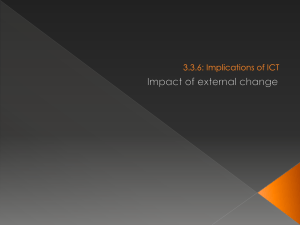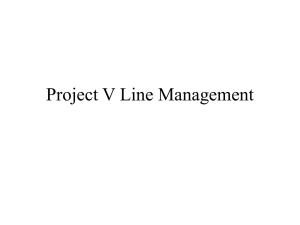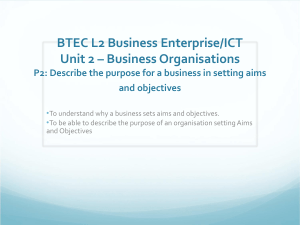Knowledge Management
advertisement
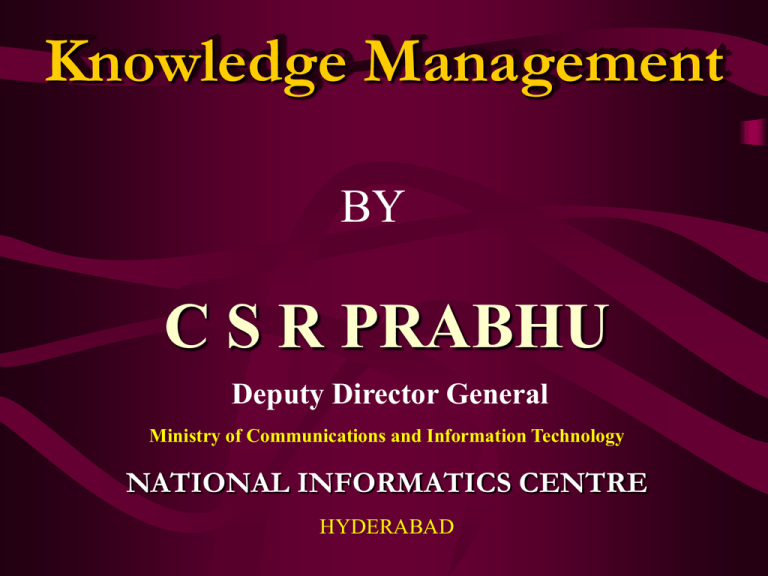
Knowledge Management BY C S R PRABHU Deputy Director General Ministry of Communications and Information Technology NATIONAL INFORMATICS CENTRE HYDERABAD Knowledge Management Definition Knowledge management is the process of discovery, acquisition, creation, dissemination and utilization of knowledge for the organization. Knowledge Management Knowledge has been recognized as an important productivity factor for the organization Knowledge Management Working Definition Knowledge Management is a discipline that seeks to improve the performance of individuals and organisations by maintaining and leveraging the present and future value of knowledge assets. Knowledge Management The three basic means of human knowledge acquisition are : to discover - One can discover something all by oneself to study and to communicate - One can obtain knowledge from others by studying information that has previously been recorded or by communicating directly with them. Knowledge Management Knowledge management is in practice in many organisations for the purpose of achieving, • Improvement in operating efficiency of business processes which benefit from having access to superior information at the point of need e.g customer-facing and marketing processes, product development etc • A knowledge-empowered organisation • A way of addressing concerns over the loss of corporate memory arising from the increasing mobility of labour Knowledge Management Principles of Knowledge Management Knowledge Management is a discipline Knowledge is shareable in the organisation Cultural change is not automatic Create a change management plan Stay strategic Pick a topic, go in-depth, keep it current Don’t get hung up on the limitations Set expectations or risk extinction Integrate KM into existing systems Educate your self-service users Knowledge Management Significance of Knowledge Management Track, measure, share and make use of intangible assets in an Organisation Paying attention to ensure that they are capturing, sharing and using productive knowledge within their organisations to enhance learning and improve performance. Knowledge Management Critical success factors can be categorized as follows Leadership Culture Structure, roles, and responsibilities Information technology infrastructure Measurement. Knowledge Management Knowledge and Learning Data, Information, Knowledge • Data – raw facts; numbers • Information – data in context; readily captured in documents and databases • Knowledge – information plus experience to act upon Knowledge Management Knowledge involves a higher degree of certainty or validity than information BASICS to Knowledge : • Information • Values • Beliefs • Experiences • Rules and Procedures Knowledge Management Knowledge and Learning Learning Organisation It facilitates the learning of its members and continuously transforms itself. In a learning organisation everyone, and the organization as well, are engaged in a continuous learning process. Knowledge Management Teaching Organisation In a teaching organisation everyone is a teacher, everyone is a learner and reciprocal teaching and learning are embodied into everyday activities. Teachers belong to the organisation and the teaching process is completely developed with organisational resources. Knowledge Management Coaching Organisation Creates an environment where the behaviors and practices involved in continuous learning exchange both explicit and tacit knowledge; reciprocal coaching and self-leadership development are actively encouraged and facilitated Coaching relationship with his/her training involves mutual commitment, trust and respect. Knowledge Organisation Knowledge Management Successful organizations are often described as Knowledge Organizations composed of knowledge workers who continually perform knowledge intensive tasks using and creating new knowledge. Successful organisations create new knowledge, share and spread this knowledge through the entire organization and quickly embody it in new products and technologies. Knowledge Management Organisation knowledge is frequently categorised into •Tacit knowledge – personal; wisdom and experience; context-specific; more difficult to extract and codify Can be transmitted through social interactions and socialisation •Explicit knowledge – what is recorded; easily identified, articulated, shared •Cultural knowledge – Cultural Ethos specific to a line of business or region or language or relegion or nation. Conceptual Frame Work of Knowledge Management A Conceptual Architecture is Required to Position Technologies Relevant to KM and Provide a Context For Selection Interface Knowledge Management services Knowledge Portal Discovery Services Collaboration Services Taxonomy Knowledge map Information and process management Infrastructure Information and Knowledge Sources Knowledge Repository E-mail, file servers, Internet / intranet services WP Email Corporate Databases Collaboration Services Discovery services Knowledge Map Knowledge Repository World Wide Web People supports knowledge sharing helps users to retrieve and analyse the information in the corporate memory provides a corporate schema for knowledge classifications provides the information management functions for captured knowledge Knowledge Management Characteristics of KM Implementation Trends Key Problems knowledge enterprises face today are : Poor utilisation of knowledge Information and knowledge islands Knowledge loss High cost of sharing knowledge Reinvention / Repetitions Lack of responsiveness Knowledge Management Characteristics of KM Implementation Trends Popular Application Areas : Most oragnisations have an interest to manage and increase their knowledge in the following areas : Customer Needs / Preferences Performance Trends / Variations Competitor Plans, Products, Market Perceptions Knowledge Management Characteristics of KM Implementation Trends Approaches Adopted : Society Centric Approach – Treats knowledge management as a social communication process Process Centric Approach mapping in business process – Focuses on knowledge Technology Centric Approach - Focuses on knowledge artifacts their creation storage and reuse in IT systems. Knowledge Management Characteristics of KM Implementation Trends Typical Activities : Appointment of Knowledge leader Creation of knowledge teams Development of knowledge bases Knowledge centres Knowledge sharing Intellectual asset management Knowledge Management


